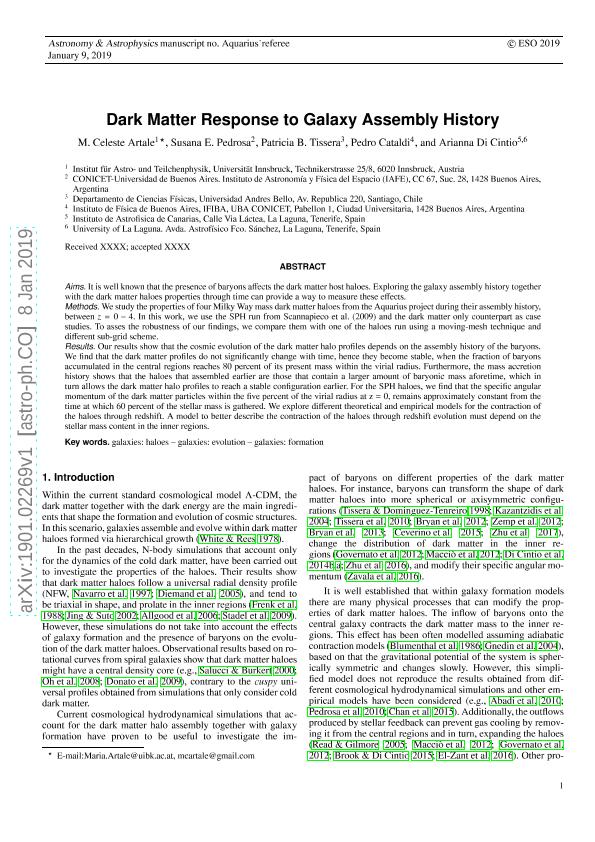Artículo
Dark matter response to galaxy assembly history
Artale, María Celeste; Pedrosa, Susana Elizabeth ; Tissera, Patricia Beatriz
; Tissera, Patricia Beatriz ; Cataldi, Pedro Anselmo
; Cataldi, Pedro Anselmo ; Di Cintio, Arianna
; Di Cintio, Arianna
 ; Tissera, Patricia Beatriz
; Tissera, Patricia Beatriz ; Cataldi, Pedro Anselmo
; Cataldi, Pedro Anselmo ; Di Cintio, Arianna
; Di Cintio, Arianna
Fecha de publicación:
02/2019
Editorial:
EDP Sciences
Revista:
Astronomy and Astrophysics
ISSN:
0004-6361
Idioma:
Inglés
Tipo de recurso:
Artículo publicado
Clasificación temática:
Resumen
Aims. It is well known that the presence of baryons affects the dark matter host haloes. Exploring the galaxy assembly history together with the dark matter haloes properties through time can provide a way to measure these effects. Methods. We study the properties of four Milky Way mass dark matter haloes from the Aquarius project during their assembly history, between z = 0 − 4. In this work, we use the SPH run from Scannapieco et al. (2009) and the dark matter only counterpart as case studies. To asses the robustness of our findings, we compare them with one of the haloes run using a moving-mesh technique and different sub-grid scheme. Results. Our results show that the cosmic evolution of the dark matter halo profiles depends on the assembly history of the baryons. We find that the dark matter profiles do not significantly change with time, hence they become stable, when the fraction of baryons accumulated in the central regions reaches 80 percent of its present mass within the virial radius. Furthermore, the mass accretion history shows that the haloes that assembled earlier are those that contain a larger amount of baryonic mass aforetime, which in turn allows the dark matter halo profiles to reach a stable configuration earlier. For the SPH haloes, we find that the specific angular momentum of the dark matter particles within the five percent of the virial radius at z = 0, remains approximately constant from the time at which 60 percent of the stellar mass is gathered. We explore different theoretical and empirical models for the contraction of the haloes through redshift. A model to better describe the contraction of the haloes through redshift evolution must depend on the stellar mass content in the inner regions.
Palabras clave:
GALAXIES: HALOS
,
GALAXY: EVOLUTION
,
GALAXY: FORMATION
Archivos asociados
Licencia
Identificadores
Colecciones
Articulos(IAFE)
Articulos de INST.DE ASTRONOMIA Y FISICA DEL ESPACIO(I)
Articulos de INST.DE ASTRONOMIA Y FISICA DEL ESPACIO(I)
Citación
Artale, María Celeste; Pedrosa, Susana Elizabeth; Tissera, Patricia Beatriz; Cataldi, Pedro Anselmo; Di Cintio, Arianna; Dark matter response to galaxy assembly history; EDP Sciences; Astronomy and Astrophysics; 622; A197; 2-2019; 1-17
Compartir
Altmétricas



